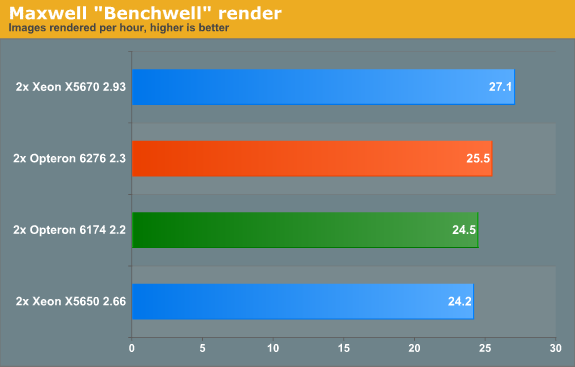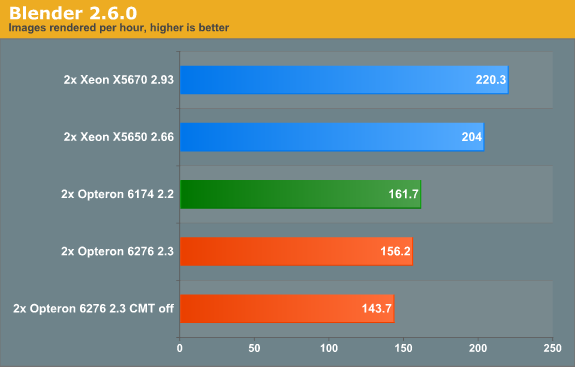Bulldozer for Servers: Testing AMD's "Interlagos" Opteron 6200 Series
by Johan De Gelas on November 15, 2011 5:09 PM ESTMaxwell Render Suite
The developers of Maxwell Render Suite--Next Limit--aim at delivering a renderer that is physically correct and capable of simulating light exactly as it behaves in the real world. As a result their software has developed a reputation of being powerful but slow. And "powerful but slow" always attracts our interest as such software can be quite interesting benchmarks for the latest CPU platforms. Maxwell Render 2.6 was released less than two weeks ago, on November 2, and that's what we used.
We used the "Benchwell" benchmark, a scene with HDRI (high dynamic range imaging) developed by the user community. Note that we used the "30 day trial" version of Maxwell. We converted the time reported to render the scene in images rendered per hour to make it easier to interprete the numbers.

Since Magny-cours made its entrance, AMD did rather well in the rendering benchmarks and Maxwell is no difference. The Bulldozer based Opteron 6276 gives decent but hardly stunning performance: about 4% faster than the predecessor. Interestingly, the Maxwell renderer is not limited by SSE (Floating Point) performance. When we disable CMT, the AMD Opteron 6276 delivered only 17 frames per second. In other words the extra integer cluster delivers 44% higher performance. There is a good chance that the fact that you disable the second load/store unit by disabling CMT is the reason for the higher performance that the second integer cluster delivers.
Rendering: Blender 2.6.0
Blender is a very popular open source renderer with a large community. We tested with the 64-bit Windows version 2.6.0a. If you like, you can perform this benchmark very easily too. We used the metallic robot, a scene with rather complex lighting (reflections) and raytracing. To make the benchmark more repetitive, we changed the following parameters:
- The resolution was set to 2560x1600
- Antialias was set to 16
- We disabled compositing in post processing
- Tiles were set to 8x8 (X=8, Y=8)
- Threads was set to auto (one thread per CPU is set).
To make the results easier to read, we again converted the reported render time into images rendered per hour, so higher is better.

Last time we checked (Blender 2.5a2) in Windows, the Xeon X5670 was capable of 136 images per hour, while the Opteron 6174 did 113. So the Xeon was about 20% faster. Now the gap widens: the Xeon is now 36% faster. The interesting thing that we discovered is that the Opteron is quite a bit faster when benchmarked in linux. We will follow up with some Linux numbers in the next article. The Opteron 6276 is in this benchmark 4% slower than its older brother, again likely due in part to the newness of its architecture.











106 Comments
View All Comments
DigitalFreak - Tuesday, November 15, 2011 - link
Good to see that CPU-Z correctly reports the 6276 as 8 core, 16 thread, instead of falling for AMD's marketing BS.N4g4rok - Tuesday, November 15, 2011 - link
If each module possess two integer cores to a shared floating point core, what's to say that it can't be considered as a practical 16 core?phoenix_rizzen - Tuesday, November 15, 2011 - link
Each module includes 2x integer cores, correct. But the floating point core is "shared-separate", meaning it an be used as two separate 128-bit FPUs or as a single 256 FPU.Thus, each Bulldozer module can run either 3 or 4 threads simultaneously:
- 2x integer + 2x 128-bit FP threads, or
- 2x integer + 1x 256-bit FP threads
It's definitely a dual-core module. It's just that the number of threads it can run is flexible.
The thing to remember, though, is that these are separate hardware pipelines, not mickey-moused hyperthreaded pipelines.
JohanAnandtech - Tuesday, November 15, 2011 - link
You can get into a long discussion about that. The way that I see it, is that part of the core is "logical/virtual", the other part is real in Bulldozer . What is the difference between an SMT thread and CMT thread when they enter the fetch-decode stages? Nothing AFAIK, both instructions are interleaved, and they both have a "thread tag".The difference is when they are scheduled, the instructions enters a real core with only one context in the CMT Bulldozer. With SMT, the instructions enter a real core which still interleave two logical contexts. So the core still consists of two logical cores.
It is gets even more complicated when look at the FP "cores". AFAIK, the FP cores of Interlagos are nothing more than 8 SMT enabled cores.
alpha754293 - Tuesday, November 15, 2011 - link
I think that Johan is partially correct.The way I see it, the FPU on the Interlagos is this:
It's really a 256-bit wide FPU.
It can't really QUITE separate the ONE physical FPUs into two 128-bit wide FPUs, but it more probably in reality, interleaves them (which is really just code for "FPU-starved").
Intel's original HTT had this as a MAJOR problem, because the test back then can range from -30% to +30% performance increase. Floating-point intensive benchmarks have ALWAYS suffered mostly because suppose you're writing a calculator using ONLY 8-byte (64-bit) double precision.
NORMALLY, that should mean that you should be able to crunch through four DWORDs at the same time. And that's kinda/sorta true.
Now, if you are running two programs, really...I don't think that the CPU, the compiler (well..maybe), the OS, or the program knows that it needs to compile for 128-bit-wide FPUs if you're going to run two instances or two (different) calculators.
So it's resource starved in trying to do the calculation processes at the same time.
For non-FPU-heavy workloads, you can get away with that. For pretty much the entire scientific/math/engineering (SME) community; it's an 8-core processor or a highly crippled 16-core processor.
Intel's latest HTT seems to have addressed a lot of that, and in practical terms, you can see upwards of 30% performance advantage even with FPU-heavy workloads.
So in some cases, the definition of core depends on what you're going to be doing with it. For SME/HPC; it's good cuz it can do 12-actual-cores worth of work with 8 FPUs (33% more efficient), but sucks because unless they come out with a 32-thread/16-core monolithic die; as stated, it's only marginally better than the last. It's just cheaper. And going to get incrementally faster with higher clock speeds.
alpha754293 - Tuesday, November 15, 2011 - link
P.S. Also, like Anand's article about nVidia Optimus:Context switching even at the CPU level, while faster, is still costly. Perhaps maybe not nearly as costly as shuffling data around; but it's still pretty costly.
Samus - Wednesday, November 16, 2011 - link
Ouch, this is going to be AMD's Itanium. That is, it has architecture adoption problems that people simply won't build around. Maybe less substantial than IA64, but still a huge performance loss because of underutilized integer units.leexgx - Wednesday, November 16, 2011 - link
think they way CPU-z reporting it for BD cpus is correct each core has 2 FP, so 8 cores and 16 threads is correctto bad windows does not understand how to spread the load correctly on an amd cpu (windows 7 with HT cpus Intel works fine, spreads the load correctly, SP1 improves that more but for Intel cpus only)
windows 7 sp1 makes biger use of core parking and gives better cpu use on Intel cpus as i have been seeing on 3 systems most work loads now stay on the first 2 cores and the other 2 stay parked, on amd side its still broke with cool and quite enabled
Stuka87 - Tuesday, November 15, 2011 - link
So, what is your definition of a core?Bulldozers do not utilize hyper threading, which takes a single integer core and can at times put two threads into that single integer core. A Bulldozer core has actual hardware two run two threads at the same time. This would suggest there are two physical cores.
Does it perform like an intel 16 core (if there was such a thing), no. But that does not mean that it is not in fact a 16 core device. As the hardware is there. Yes they share an FPU, but that doesn't mean they are not cores.
Filiprino - Tuesday, November 15, 2011 - link
Actually, Bulldozer is 16 cores. It has two dedicated integer units and a float point unit which can act as two 128 bit units or one 256 bit unit for AVX. So, you can have 2 and 2 per module.Bulldozer does not use hyperthreading.